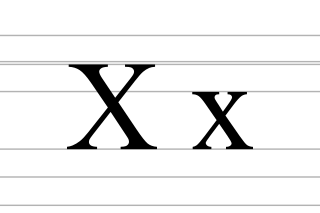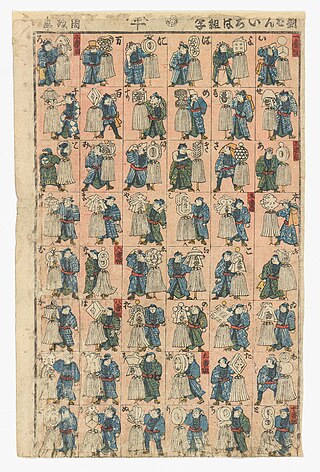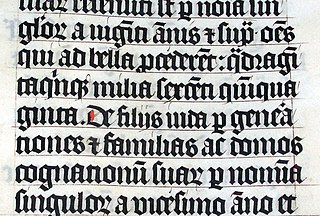Footnotes
- ↑ "The earliest use of the F-word discovered". Medievalists.net. 10 September 2015. Retrieved 13 September 2015.
- 1 2 3 "fuck". The American Heritage Dictionary of the English Language (5th ed.). HarperCollins.
Flen flyys (Middle English: "Fleas (and) flies") is the colloquial name and first words of an anonymous, untitled poem, written about 1475 or earlier, famous for containing an early written usage in English of the vulgar verb "fuck". [1] In fact the usage was "fuccant", a hybrid of an English root with a Latin conjugation, and was disguised in the text by a simple code, in which each letter was replaced with the next letter in the alphabet of the time (so that fuccant is written as gxddbou). [2]
Written half in English and half in Latin, the poem satirised Carmelite friars in the English county of Cambridgeshire. The poem takes its name from the opening line Flen, flyys and freris meaning "fleas, flies and friars". [2]
The famous line reads "Non sunt in coeli, quia gxddbov xxkxzt pg ifmk." meaning "They [the friars] are not in heaven, since ..." followed by words that when decoded, taking in account the alphabet of the time (where u and v were interchangeable, as were i and j, and uu represented w), read "fvccant vvivys of heli", a Latin/English mix that means "...they fuck the wives of Ely" (Ely being a city near Cambridge) as well as being a pun on the word "hell". [2]
The poem also contains the lines "Fratres cum knyvys goth about and txxkxzv nfookt xxzxkt." With the last three words decoded in the same way as "svvivyt mennis vvyvis," it may be translated as "Friars with knives go about and swive (have sex with) men's wives."
The poem is found in British Library, Harley MS 3362, and was first edited in T. Wright & J. O. Halliwell, Reliquiæ Antiquæ (1841) 1.91. The Oxford English Dictionary (online edition) cites Flen flyys in square brackets, since the form fuccant is Anglo-Latin and not strictly speaking English.

The Arabic alphabet, or the Arabic abjad, is the Arabic script as specifically codified for writing the Arabic language. It is written from right-to-left in a cursive style, and includes 28 letters, of which most have contextual letterforms. Unlike the Latin alphabet, the script has no concept of letter case. The Arabic alphabet is considered an abjad, with only consonants required to be written; due to its optional use of diacritics to notate vowels, it is considered an impure abjad.
The identity of the longest word in English depends on the definition of a word and of length.

X, or x, is the twenty-fourth letter of the Latin alphabet, used in the modern English alphabet, the alphabets of other western European languages and others worldwide. Its name in English is ex, plural exes.

Ancient Egyptian hieroglyphs were the formal writing system used in Ancient Egypt for writing the Egyptian language. Hieroglyphs combined ideographic, logographic, syllabic and alphabetic elements, with more than 1,000 distinct characters. Cursive hieroglyphs were used for religious literature on papyrus and wood. The later hieratic and demotic Egyptian scripts were derived from hieroglyphic writing, as was the Proto-Sinaitic script that later evolved into the Phoenician alphabet. Egyptian hieroglyphs are the ultimate ancestor of the Phoenician alphabet, the first widely adopted phonetic writing system. Moreover, owing in large part to the Greek and Aramaic scripts that descended from Phoenician, the majority of the world's living writing systems are descendants of Egyptian hieroglyphs—most prominently the Latin and Cyrillic scripts through Greek, and possibly the Arabic and Brahmic scripts through Aramaic.
Constrained writing is a literary technique in which the writer is bound by some condition that forbids certain things or imposes a pattern.

Thorn or þorn is a letter in the Old English, Old Norse, Old Swedish and modern Icelandic alphabets, as well as modern transliterations of the Gothic alphabet, Middle Scots, and some dialects of Middle English. It was also used in medieval Scandinavia but was later replaced with the digraph th, except in Iceland, where it survives. The letter originated from the rune ᚦ in the Elder Futhark and was called thorn in the Anglo-Saxon and thorn or thurs in the Scandinavian rune poems. It is similar in appearance to the archaic Greek letter sho (ϸ), although the two are historically unrelated. The only language in which þ is currently in use is Icelandic.
The abbreviation viz. is short for the Latin videlicet, which itself is a contraction of the Latin phrase videre licet, meaning "it is permitted to see". It is used as a synonym for "namely", "that is to say", "to wit", "which is", or "as follows". It is typically used to introduce examples or further details to illustrate a point: for example, "all types of data viz. text, audio, video, pictures, graphics, can be transmitted through networking".
Estonian orthography is the system used for writing the Estonian language and is based on the Latin alphabet. The Estonian orthography is generally guided by phonemic principles, with each grapheme corresponding to one phoneme.

An acrostic is a poem or other word composition in which the first letter of each new line spells out a word, message or the alphabet. The term comes from the French acrostiche from post-classical Latin acrostichis, from Koine Greek ἀκροστιχίς, from Ancient Greek ἄκρος "highest, topmost" and στίχος "verse". As a form of constrained writing, an acrostic can be used as a mnemonic device to aid memory retrieval. When the last letter of each new line forms a word it is called a telestich; the combination of an acrostic and a telestich in the same composition is called a double acrostic.

The Iroha (いろは) is a Japanese poem. Originally the poem was attributed to Kūkai, the founder of Shingon Buddhism, but more modern research has found the date of composition to be later in the Heian period (794–1179). The first record of its existence dates from 1079. It is famous because it is a perfect pangram, containing each character of the Japanese syllabary exactly once. Because of this, it is also used as an ordering for the syllabary, in the same way as the A, B, C, D... sequence of the Latin alphabet.

The Russian alphabet is the script used to write the Russian language. It is derived from the Cyrillic script, which was modified in the 9th century to capture accurately the phonology of the first Slavic literary language, Old Slavonic. Initially an old variant of the Bulgarian alphabet, it was used in Kievan Rus' from the 10th century onward to write what would become the modern Russian language.

Letter case is the distinction between the letters that are in larger uppercase or capitals and smaller lowercase in the written representation of certain languages. The writing systems that distinguish between the upper- and lowercase have two parallel sets of letters: each in the majuscule set has a counterpart in the minuscule set. Some counterpart letters have the same shape, and differ only in size, but for others the shapes are different. The two case variants are alternative representations of the same letter: they have the same name and pronunciation and are typically treated identically when sorting in alphabetical order.

Scribal abbreviations, or sigla, are abbreviations used by ancient and medieval scribes writing in various languages, including Latin, Greek, Old English and Old Norse.

The modern Japanese writing system uses a combination of logographic kanji, which are adopted Chinese characters, and syllabic kana. Kana itself consists of a pair of syllabaries: hiragana, used primarily for native or naturalized Japanese words and grammatical elements; and katakana, used primarily for foreign words and names, loanwords, onomatopoeia, scientific names, and sometimes for emphasis. Almost all written Japanese sentences contain a mixture of kanji and kana. Because of this mixture of scripts, in addition to a large inventory of kanji characters, the Japanese writing system is considered to be one of the most complicated currently in use.
Ur is the recorded name for the rune ᚢ in both Old English and Old Norse, found as the second rune in all runic alphabets (futharks), i.e. Germanic Elder Futhark, Anglo-Frisian Futhark and Norse Younger Futhark. It corresponds to the letter u in the Latin alphabet, but also carries other sound values, especially in Younger Futhark, were its sound values correspond to the vowels:, , and etc., and the consonants: and etc., in the Latin alphabet.

The letter Ъ ъ of the Cyrillic script is known as er golyam in the Bulgarian alphabet, as the hard sign in the modern Russian and Rusyn alphabets, as the debelo jer in pre-reform Serbian orthography, and as ayirish belgisi in the Uzbek Cyrillic alphabet. The letter is called back yer or back jer and yor or jor in the pre-reform Russian orthography, in Old East Slavic, and in Old Church Slavonic.
Latin obscenity is the profane, indecent, or impolite vocabulary of Latin, and its uses. Words deemed obscene were described as obsc(a)ena, or improba. Documented obscenities occurred rarely in classical Latin literature, limited to certain types of writing such as epigrams, but they are commonly used in the graffiti written on the walls of Pompeii and Herculaneum. Among the documents of interest in this area is a letter written by Cicero in 45 BC to a friend called Paetus, in which he alludes to a number of obscene words without actually naming them.

Fuck is an English-language profanity that often refers to the act of sexual intercourse, but is also commonly used as an intensifier or to convey disdain. While its origin is obscure, it is usually considered to be first attested to around 1475. In modern usage, the term fuck and its derivatives are used as a noun, a verb, an adjective, an interjection or an adverb. There are many common phrases that employ the word as well as compounds that incorporate it, such as motherfucker and fuck off.
An abecedarius is a special type of acrostic in which the first letter of every word, strophe or verse follows the order of the letters in the alphabet.

English Braille, also known as Grade 2 Braille, is the braille alphabet used for English. It consists of around 250 letters (phonograms), numerals, punctuation, formatting marks, contractions, and abbreviations (logograms). Some English Braille letters, such as ⠡⟨ch⟩, correspond to more than one letter in print.